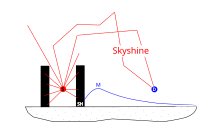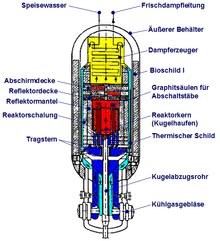Skyshine
 From Wikipedia - Reading time: 5 min
From Wikipedia - Reading time: 5 min

(Radiation) skyshine describes the ionizing radiation emitted by a nuclear technical or medical facility, reaching the facility's surroundings not directly, but indirectly through reflection and scattering at the atmosphere back to Earth's surface. This effect can happen when the shielding barrier around the source of radiation is open at the top.[2][3] This effect can also happen when the shielding in the vault room of a linear particle accelerator in radiation therapy is not sufficient to reduce the intensity of the primary incident beam down to a very low level.[4] For example, a member of the public may be positioned outside of such a room or vault in a nearby parking lot. For a radiation therapy facility with limited shielding in the vault ceiling, even if the radiation is directed straight upward through the ceiling into the atmosphere, there can still be a significant amount of radiation scattering off of the atmosphere backward and at an angle. This skyshine can be measured by a medical physicist at the position of the pedestrian standing on the ground in the nearby parking lot. Such radiation is generally measured in terms of exposure-rate or dose-rate. It has been shown that this downward intensity is heavily dependent on the shape of the beam. Regardless of whether the upward incident beam is shaped like a circle, square or rectangle, specific calculation formalism has been described.[5][6] The intensity of radiation measured at the surface immediately surrounding the facility increases with growing distance from the shielding barrier to reach a maximum and then fall again continuously with further increasing distance. Depending on the energy of the scattering radiation, the intensity maximum is reached at different distances from the vault. For example, x-rays emitted from linear accelerators reached maxima of 18 MeV at a distance of 13.6 m and 6 MeV at 4.6 m in studies.[4]

Between 1967 and 1975 significant radiation damage of the surroundings[clarification needed] was caused by radiation skyshine at and near the AVR reactor in Jülich, Germany, which, in its original BBC construction, lacked a top shielding barrier.[7][8][9]
In 2011, the skyshine effect reached media attention in the controversy around the radioactive waste repository Gorleben after higher levels of radiation were measured outside the facility, despite it being shielded by a shielding wall.[10]
References
[edit]- ^ Lagutina [Лагутина], I. S. [И. С.]; Mashkovich [Машкович], V. P. [В. П.]; Stroganov [Строганов], A. A. [А. А.]; Chernyaev [Черняев], Alexander M. [А. М.] (February 1989). "Skyshine from photon radiation". Soviet Atomic Energy. 66 (2). Kluwer Academic Publishers / Plenum Publishers: 118–124. doi:10.1007/BF01121800. eISSN 1573-8205. ISSN 0038-531X. S2CID 94534785. (NB. Translation from article Скайшайн фотонного излучения in the Russian journal Atomnaya Énergiya [Атомная энергия], pp. 103–106. [1])
- ^ Kase, Kenneth R.; Edwards, Marc; Gorson, Robert O.; Ipe, Nisy E.; Kleck, Jeffrey H. (2005). "contribution". Structural Shielding Design and Evaluation for Megavoltage X- and Gamma-Ray Radiotherapy Facilities. By Deye, James A.; Rodgers, James E.; Wu, Raymond K.; Biggs, Peter J.; McCall, Richard C.; McGinley, Patton H. National Council on Radiation Protection and Measurements (NCRP). ISBN 978-0-929600-87-1. ISBN 0-929600-87-8. Report No. 151. Retrieved 2016-05-17. [2]
- ^ "Verantwortung im Strahlenschutz bei Arbeiten in und mit Fremdfirmen" (PDF) (in German). Landesanstalt für Arbeitsschutz NRW. 2001-05-01. Retrieved 2011-11-27.
- ^ a b Gossman, Michael S.; McGinley, Patton H.; Rising, Mary B.; Pahikkala, A. Jussi (May 2010) [2009-02-16]. "Radiation skyshine from a 6 MV medical accelerator". Journal of Applied Clinical Medical Physics. 11 (3). Archived from the original on 2016-05-17. Retrieved 2016-05-17.
- ^ Gossman, Michael S.; Pahikkala, A. Jussi; Rising, Mary B.; McGinley, Patton H. (May 2010) [2009-02-16]. "Providing solid angle formalism for skyshine calculations". Journal of Applied Clinical Medical Physics. 11 (4): 278–282. doi:10.1120/jacmp.v11i4.3286. PMC 5720402. PMID 21081888.
- ^ Gossman, Michael S.; Pahikkala, A. Jussi; Rising, Mary B.; McGinley, Patton H. (May 2010) [2009-02-16]. "Letter to the Editor". Journal of Applied Clinical Medical Physics. 12 (1): 242–243. doi:10.1120/jacmp.v12i1.3530. PMC 5718598. PMID 21330993. Archived from the original on 2022-05-05. Retrieved 2022-05-05.
- ^ Ministerium für Arbeit, Gesundheit und Soziales (MAGS NRW) / Atomaufsicht [in German] (1975-01-23). Dosisleistungen im AVR-Gelände und am Reaktorgebäude (in German). Düsseldorf, Germany. Geschäftszeichen III A 4–8944,65.
{{citation}}: CS1 maint: location missing publisher (link) (NB. In compliance with the German Umweltinformationsgesetz (UIG) this document can be inspected on request in the archive of the Ministerium für Arbeit, Gesundheit und Soziales (MAGS), Düsseldorf, Germany.) - ^ AVR GmbH (1975-07-17). Schreiben der AVR GmbH an das MAGS/Atomaufsicht (Düsseldorf) (in German). Jülich, Germany. Az H4-S5a4 Ku/Lö.
{{citation}}: CS1 maint: location missing publisher (link) (NB. In compliance with the German Umweltinformationsgesetz (UIG) this letter can be inspected on request in the archive of the Ministerium für Arbeit, Gesundheit und Soziales (MAGS), Düsseldorf, Germany.) - ^ Langen, Andreas (2011-12-28). "Gebt uns die Kugel". Kontext:Wochenzeitung (in German) (39). Kontext:Verein für Ganzheitlichen Journalismus e. V. Archived from the original on 2016-05-17. Retrieved 2016-05-17. Langen, Andreas (2012-01-04). "Strahlendes Glanzstück". Kontext:Wochenzeitung (in German) (40). Kontext:Verein für Ganzheitlichen Journalismus e. V. Archived from the original on 2016-05-17. Retrieved 2016-05-17.
- ^ Metzner, Wolfgang [in German] (2011-11-25). ""Skyshine" über dem Castor-Lager". stern (in German). Archived from the original on 2016-05-17. Retrieved 2016-05-17.
 KSF
KSF